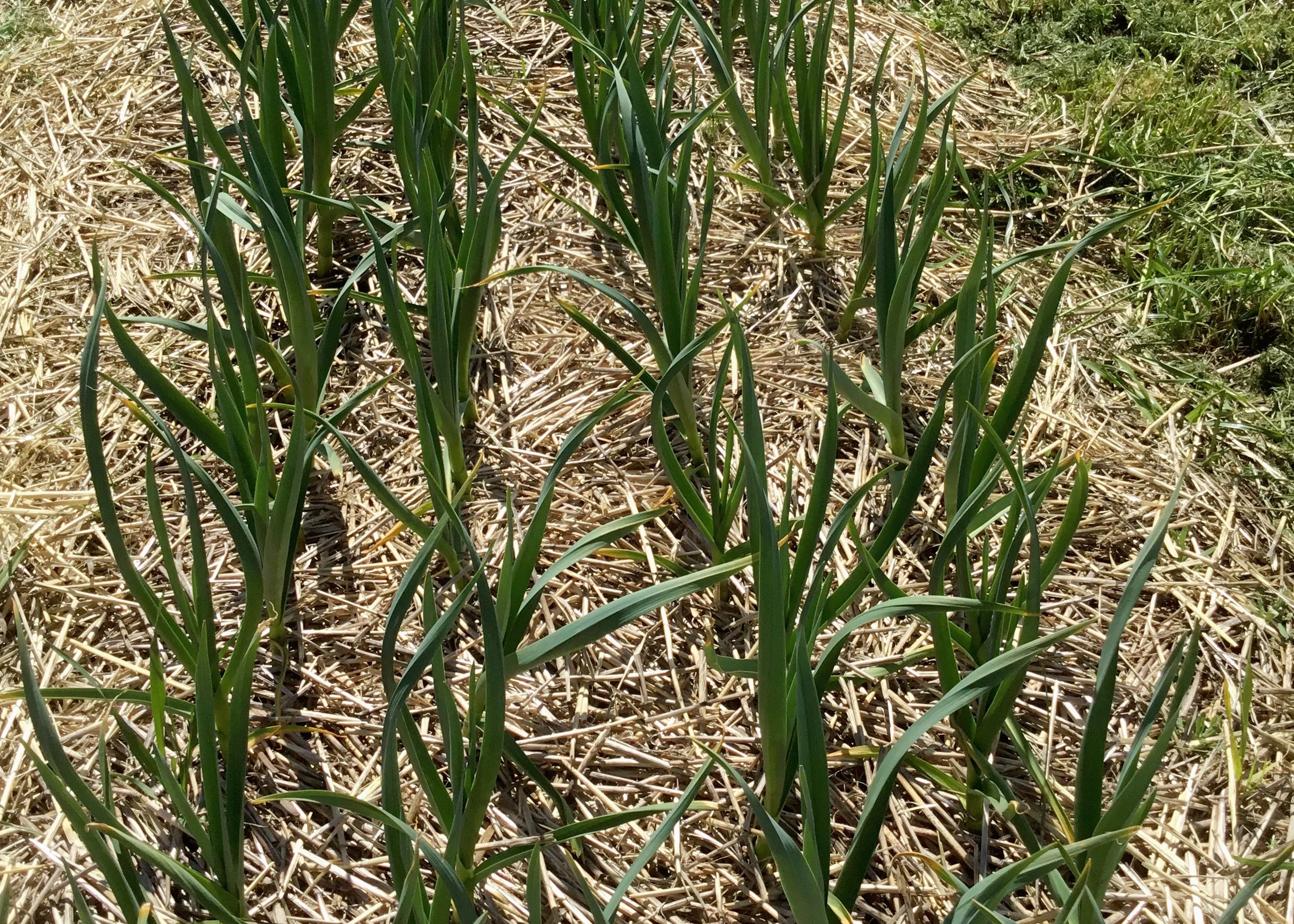Enjoying Garlic Through the Seasons
Garlic is a pleasure to grow and is one of the most useful ingredients in your pantry. This amazing plant offers so much more than its cloves for culinary use. What follows are some of the many ways that you can use parts of ol’ Allium sativum to enjoy your homegrown garlic all throughout the year.
Spring Garlic aka Garlic Scallions
Depending on where you live, anywhere from mid-winter to mid spring you will find your new garlic plants emerging from the cold soil and offering your first fresh garlic treat of the year. Any time before the garlic gets over about a foot and a half tall, the green leaves are tender with the root end blanched and sweet. Carefully lift or pull these young garlic plants out of the ground. You may find the base of your plant is still encased in last year’s clove. After gently removing the clove, chop and enjoy the way you would regular scallions, either fresh or lightly sautéed. Their flavor is mild and very sweet. Use this opportunity to thin tightly planted cloves or those ‘doubles’ that occasionally come up. Next fall, consider using up the smallest cloves from your planting stock in a little patch that you will designate for spring garlic – all that’s required for this special crop is about 1 or 2 square inches for each plant.
2. Garlic Greens
Around the same time of year as spring garlic, the green tops of the garlic are remarkably tender and mild and can make a great addition to soups, sauces, and pestos. They can also be used as a stand-in for chives. You can harvest the greens multiple times but doing so sacrifices the eventual size of the bulb, so do so only on plants designated for greens.
3. Green Garlic
In mid spring, the plant will begin to bulb at the base, below ground. At any point between now and the main harvest, you can enjoy fresh green garlic. This is one of my favorite ways to enjoy garlic and monitor the natural process of bulb and clove formation. In the early stages of bulbing, you will find a single solid mass with very thin skin and little to no differentiation between the cloves. As the plant matures, the cloves will become more defined with tender ‘wrappers’ forming between them. As the bulb grows and the cloves become more defined, the skins will thicken and need to be removed before eating. The flavor of the garlic progresses through this stage from sweet and mild to more pungent, approaching the flavor of freshly dug garlic.
4. Garlic Scapes
Undoubtedly the most popular way to consume garlic pre-harvest is to enjoy the tender, curling flower stalks that emerge from the tops of hardneck garlic varieties. Scapes are one of those exceptionally special seasonal treats that are fleeting and should not be missed. Here in the Pacific Northwest, scapes typically appear during the first half of June. These curious curlicues have a texture that resembles asparagus and are often prepared by steaming, sautéing, or grilling. Since they are the flower stalk of the plant, they are high in sugar with a mild garlic flavor. There are many ways to enjoy garlic scapes, but my favorites are grilled, blended into a pesto, or lacto-fermented. (For the culinarily adventurous, the fermented scapes can also be cooked for an otherworldly experience). Porcelain garlic types create the thickest and most tender scapes – one of the reasons I tend to plant more porcelains than other types. Rocamboles and turban garlics create smaller, more strongly flavored scapes that tend to get fibrous quickly. Purple stripe garlics are somewhere in between. Scapes will emerge from the top of the plant and will grow very quickly-- sometimes a couple inches per day. They curl around one or more times while growing, and then eventually straighten out and stand vertically, becoming tough enough to support the weight of the flower. The key to harvesting scapes is to let them get as large as possible before they turn woody. For most varieties, I recommend harvesting when the scape has completed a 270-degree turn. Scapes can be cut or snapped off at the top of the plant where it joins the top leaf. If you have patience and a subtle touch, you can gently but firmly pull the scape out of the plant, doing so will give you another foot or two of very tender blanched scape stem. This takes patience and a little practice but done correctly does not harm the formation of the bulb. Though debatable, it is generally recommended to remove the scapes from the plant anyway to redirect the plant’s energy from flower formation to encourage bulb formation.
5. Main Harvest Garlic
We’re all familiar with the standard dried garlic bulb and have written about it extensively.
We also have a video with our garlic harvest tips you can watch!
In order to get the longest period of use from your garlic harvest, plan on growing both softnecks and hardnecks. Maintaining optimal conditions during curing and storage is crucial to maximizing the shelf life of your garlic. Be sure to label and bag your garlic varieties separately and plan to eat the hardnecks first. Save the softnecks for the winter months. With good curing and storage, you can enjoy last year’s garlic harvest up until the garlic emerges next spring and the garlic-eating season begins again!
6. Perfect Roasted Garlic Anytime!
If you have an exceptionally large garlic harvest, you can process the heads for storage. This works especially well for hardneck types that might not keep. Cut the tops off the heads to expose a portion of each clove. Arrange the heads on a cookie sheet and drizzle with a little olive oil. Roast the heads at 350°F until soft and caramelized. Allow the heads to cool and store in a Ziplock bag in the freezer. To use, defrost whole heads in the microwave (only about 20 seconds), or allow them to come to room temperature on the counter; the heads thaw very quickly. It’s an excellent way to have delicious roasted garlic at your fingertips for recipes or as a spread on fresh, crusty bread.
After just one season of relishing garlic in its many forms, you’ll find yourself planting more garlic than you ever thought you would so you can indulge in the many options that this plant produces year-round.
Author: Andrew B.









